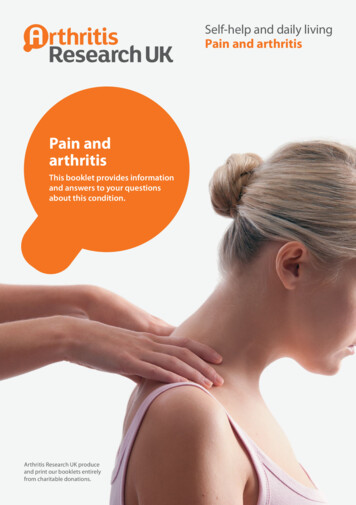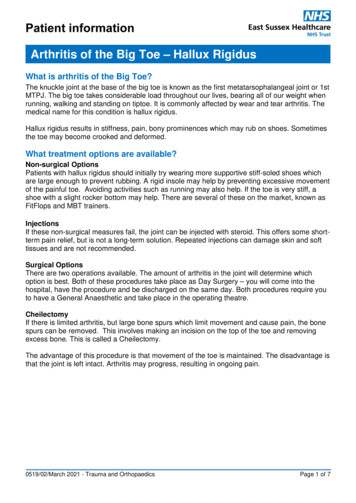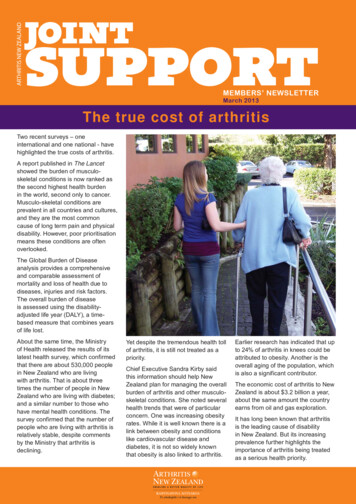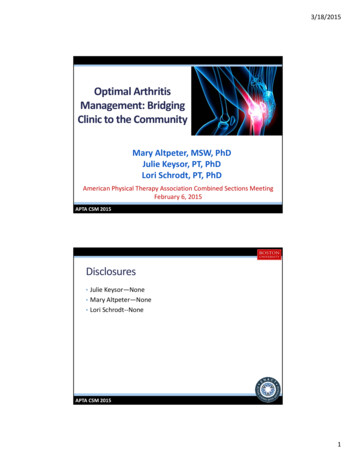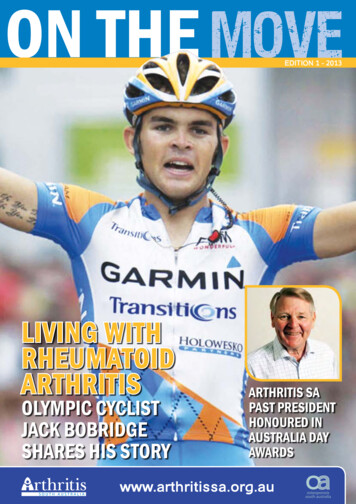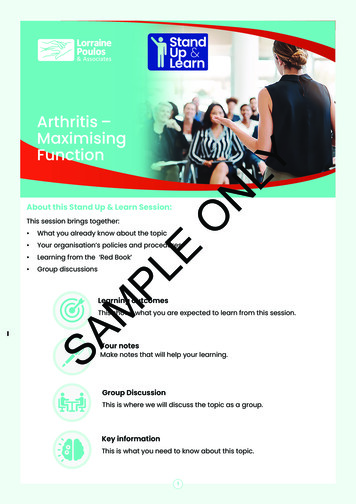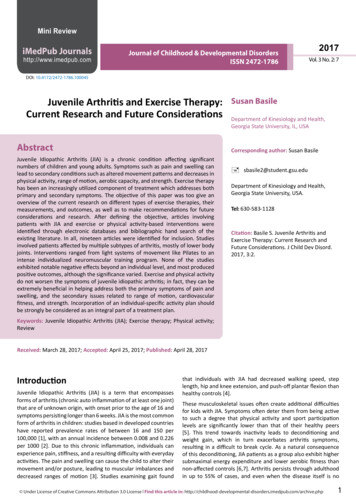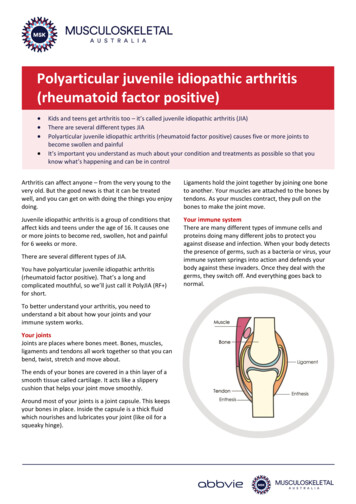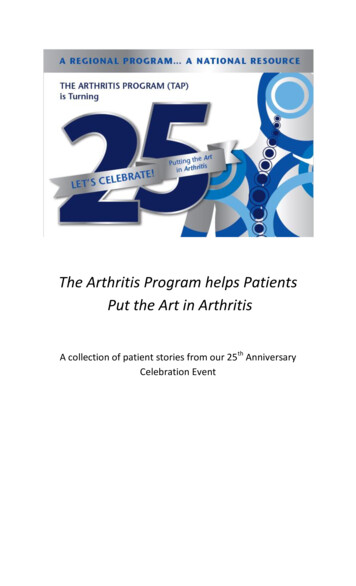
Transcription
The Arthritis Program helps PatientsPut the Art in ArthritisA collection of patient stories from our 25th AnniversaryCelebration Event
ANITA STEPHENSONDr. Carter Thorne and his team at The Arthritis Program saved my life. On May 20 1997, afterspending close to 8 months in bed or on the sofa, Dr. Thorne diagnosed me with severerheumatoid arthritis. He strongly suggested, and said that I really needed to attend the 3 weekprogram, and I am extremely glad that I did.Throughout my life, in one way or another, art has always been a passion; and that is exactlywhat all of the members of TAP share with every one of their patients, day in, day out, yearafter year. For someone who lives in a small town in Muskoka, TAP’s service is completelyinvaluable. They taught me so much about my illness and what I could do to help myself. I thinkanother very important aspect about TAP, is all of the patients who attend and what a hugesupport they are for each other. It is a comfort talking with others who understand what youare going through and we certainly weren't alone. There are far too many of us.Each week there was a meeting with every member of the team. We would discuss how I wasdoing and if I needed another cortisone injection. When issues came up with medicationreactions Marie Chambers, the pharmacist, was there to suggest different options available andcome up with ideas that would help as well. Thank you Marie!As an occupational therapist, I think Jean Painter made a splint for every part of my body!Resting splints for night time and others for when I was needing support during the day. Onesfor thumbs and ones for wrists, as well as orthotics for my shoes and the list goes on. Thank youJean!I have told Dzintra Schlotter, the physiotherapist, that even after all these years; I always thinkof her whenever I hug my pillow at night, to support my shoulder and hip. She also taught usabout the importance of monitoring our range of motion. Thank you Dzintra!They even have a social worker as part of the team, that you could speak with when it allseemed so overwhelming. Thank you Patrick Clifford!I never miss my yearly appointment with Dr. Thorne, but I can't tell you how important it is tome, that I can call The Arthritis Program on any given day and they somehow will fit me intotheir schedule. It makes being in a small town seem not so far away. It has been 19 years since Iattended TAP and some of the members have changed, but the care and the compassion neverdo.
ANNE WESTThe main challenge that I had when I joined the first fibromyalgia class in The Arthritis Programwas my sleep deprivation. Prior to my diagnosis, I had been an avid walker, but suddenly oneweek the pain in my feet got so bad that I was no longer able to walk. When this happened iswhen I started to not be able to sleep, which lead to me feeling extremely depressed.Pat Clifford, the social worker with the program was enormously helpful in getting me back to anormal daily life. He made me aware of the choices I have and how I can continue to live withmy fibromyalgia.I have always been an artist and I find that when I am either drawing or painting it makes mypain management much easier to handle. I am also an avid singer and music brings me great joyand helps to improve my overall mood.The Arthritis Program has taught me not to ‘sweat the small stuff’, to delegate and say no whenneeded, which helps me to better take care of myself and has helped me manage my diagnosisand manage my life. 'Breathe' is what I often say to myself.a good reminder to all.
ARIEL KWANThe summer prior to entering high school found me preparing for my piano and violin Associateof The Royal Conservatory (ARCT) Performer diplomas. I spent grueling three-hour practicesessions on each instrument daily, which culminated in marks of 92 and 94 in piano and violin,respectively. During this time, the joints in my hands became swollen and painful but Idismissed the symptoms as secondary to overuse.When my symptoms persisted, despite a reduction in practicing, I knew there was somethingelse going on. At age 14, I was diagnosed with juvenile idiopathic arthritis (JIA). Progression inmy hands not only affected my ability to play instruments, but also began interfering with mycapacity to write. Due to the unpredictability of flare-ups, a professional music career becameimpractical.Under the care of Dr. Carter Thorne, TAP, and with the use of multi-modal therapeutics, I wasable to face adversity and continue exploring my passion for music as a violinist with theToronto Symphony Youth Orchestra. I also toured with the prestigious National YouthOrchestra of Canada for three summers until age 18, spending my final year as concertmaster.While I am presently pursuing my studies to complete my Doctor of Pharmacy degree, Icontinue my passion for the violin as a member and co-concertmaster of University ofToronto’s Hart House Orchestra. With the exceptional care provided by the multidisciplinaryteam at TAP, music performance continues to be a reality.
BERNICE LEVERIn late 1999 I began to suffer severe random attacks of muscle pain. These attacks caused lackof sleep and fears of muscle deterioration that diminished my focus on my job as an EnglishProfessor at Seneca College. It also distracted me from writing new poems. I would suffer fromspasms and piercing knots in my arms, legs and fingers – some of these spasms would lastminutes, while others would last for over an hour.Local GP’s gave me pain pills and in 1999 I took a blood test, which I was told, “could be a falsepositive. After my second blood test my Rheumatoid Arthritis was discovered. In January of2000, I met with a rheumatoid specialist, Dr. Vincent Mak, who started me on three types ofpain pills. I started with TAP in June of 2000 where I learned, over a 6-week period, how torecover from my R.A. which also explained my psoriasis. Through the assistance of TAP Ireduced my teaching load and rested more. I retired that same year at age 64 and moved toBritish Columbia.My strength improved from hiking hills and walking the shoreline and soon I was giving writingworkshops and readings and writing more poetry, all thanks to reclaiming my body with thehelp of TAP. I now see Dr. Alive Klinkhoff of the Blue Bird Centre in Vancouver, who reads myblood tests and examines my R.A annually. Since 2000 I am on 40less medication and amimproving my daily life. My fingers and toes are somewhat warped, but do not negatively affectmy keyboard computer activities or my walking. After TAP, contentment happened withsupportive family and friends. Learning from TAP in 2000, I realized my options were “sit stilland suffer” or retrain my body and mind.
CAROL WRIGHTI was fortunate to have a career doing what I love - teaching music to students fromKindergarten to Grade 8. However, by the fall of 2013, I was struggling to do my job. It becameincreasingly painful to set and reset the room for various classes, play the piano, clean, repairand demonstrate band instruments and conduct choral and instrumental groups. Upon beingdiagnosed with Rheumatoid Arthritis (RA), I decided to put my health first and took earlyretirement.In losing my ability to teach music, and my ability to pursue my musical hobbies, I lost my senseof purpose and sense of self. My appointments and classes at TAP gave me hope that I couldbegin to move forward. As I grew more informed about the disease, medications, exercise,nutrition and attitude, I realized that while I would always be impacted by RA, I could learn tomanage it. Although I am not able to participate in music to the extent that I once did, I havebeen able to carefully re-engage in some singing and playing. I still call TAP on occasion; theworkers there are unfailingly welcoming, reassuring and informed. I cannot imagine havingcome this far without them.
CARRIE BARNESMy nickname for over 25 years has been “Sport.” I love to be on the move, enjoying all types ofsports and recreational activities. Being active is a big part of my social life, how I care for myphysical health and how I de-stress best. I also love to work with people, so choosing a career inhealthcare seemed a natural fit.I was at the prime of my life: happily married with two active boys, a fulfilling career as a nurseand lots of recreational activities to keep me moving. And then it hit me: Rheumatoid Arthritis.Arthritis disrupted my life to the point where I wasn’t able to fully care for my family or myself.I even struggled to walk comfortably, so being involved in any sort of physical activity was outof the question. I was losing a battle I didn’t ask to be in with no weapons to fight back. I wasconfused, exhausted and scared.I was introduced to The Arthritis Program at this time in my life when I thought there was nohope of ever regaining my strength or vitality. There was no prospect of a bright future and myhopes and dreams were quickly fading away.It is not an easy thing to surrender your care to someone else. However, quickly realizing thestrength of the TAP team where they all bring their best and encourage my input, I was able totrust their plan of care for me and soon began uncovering great success. I began to regain notonly function, but confidence and most importantly hope.I felt empowered to know and understand my disease better. I learned to manage mysymptoms and take back the control I felt I had lost. I was encouraged to share my strugglesand triumphs with others who were just starting out on their own journey of rediscovering theirconfidence. This allowed me to take something that seemed negative in my life and use it tomake a positive difference in the lives of others.What is my art? My art is in the discovery of who I am. My future is bright and full of hope. Iam lovable, I am capable. I am limitless in my hopes and dreams. I am complete althoughbroken. I am not afraid of what is to come, this time I’m ready.
CHRISTINA BIEBERMy name is Christina Bieber. I am 54 years young, I have two children and two grandchildren. I wasdiagnosed with inflammatory arthritis in 2015 and I am a cancer survivor as well. Both events caused adramatic change in my daily life. I used to be very active. I ran races. My last race was a half marathon threeyears ago.After I completed my treatments for cancer, I started developing joint pain. I struggled to open bottles,walking was very painful, lifting the kettle to make tea was a challenge and every day my pain got worse. Thepain and exhaustion was the same as after chemotherapy. I had no energy, everything was sore, and everymovement was a struggle. I did not want to get up. Standing on my feet, each step was so painful. I wouldtake pain medication and by the time it was effective, an hour would have passed, and even then, the painwouldn’t be gone, it would just be less. I could not even go for short walks anymore. When I attended a bigevent, like driving out of town for a wedding or playing with my grandson, I would be out of commission for acouple of days afterwards.Thanks to my family doctor and oncologist, I was referred to the arthritis program in the summer of 2015. Iwas diagnosed with inflammatory arthritis. When I got the news, I felt the same as when I was told I hadcancer. This can’t happen to me. My own body is attacking me again. I was overwhelmed and upset, and I feltlike I was living a bad dream. It took me a long time to accept the diagnosis.I received my first cortisone injection that day, and was started on a medication for the inflammatoryarthritis. I also was enrolled in the Canadian Early Arthritis Cohort (CATCH) study. In a short period of time, Iattended the education program at TAP. I learned about exercise, the disease’s progress, and tools that helpme to manage my daily life. I had an appointment to get special inserts for my shoes I struggled to get theright fit for my shoes. The staff answered questions about medications and pain management. They taughtme to do the body scan, joint counts and daily exercises. To deal with the emotional impact of my condition, Ilearned to be mindful, to relax with music, and to practice deep breathing.The CATCH study requires filling out pages that track how I’m feeling and coping with my symptoms on a dayto day basis and information on my arthritis assessment would be captured from my regular clinic visits.Participating in the study makes me feel good because I feel I can help other patients in the future.One year has passed since I was diagnosed with arthritis. I have learned a lot about how to deal with thedisease. I accept that I can’t run at this point in my life, but I can swim. I know I have to rest the day before abig activity, and have to rest the day after. I try to stay active and rest when I get tired, and accept mylimitations. I don’t give up hope that one day I might be able to run a half marathon again when my arthritisis in remission. It is hard when people see me and tell me I look so well, when in reality every day is a struggleand some days are better than others. I don’t give up hope. I am so thankful for the support and help Ireceived from TAP. I know any time something changes, or I need help, I can get in touch with them and getsupport and guidance. I am thankful that the arthritis was caught early. I am also thankful to have such aprofessional, knowledgeable team looking after me.
CINDY PHILLIPSPrior to my Rheumatoid Arthritis (RA) diagnosis 18 months ago, I led a busy life, working as anindependent bookkeeper, an avid community volunteer and I led an active life, enjoying curling,tennis and golf and more. I was diagnosed with rheumatoid arthritis in November of 2014, afterseeking treatment for what I thought were tennis injuries. With a speedy referral to Dr. Samadiand involvement in The Arthritis Program, I began medication that fall and attended theinflammatory arthritis education program in January 2015.Although I had to compromise on being able to play many of the sports I loved, I was eager toget on the ice for curling season. While not wanting to let my RA hold me back from my curlingcommitments, I worked with the TAP team and began to adjust the way I enjoyed the game andsocial life of curling. I altered my curling method and working with my teammates toaccommodate for the positions I could no longer play.This past curling season, I recognized the RA limits to my energy and gave up most coachingactivities, and was enjoying playing twice a week when I suffered a setback. Dr. Samadiinformed me that my liver function was compromised and I needed to go off methotrexatealthough it was controlling the arthritis very well. This brought on another flare that had mesidelined. Thankfully though, through medication adjustments and extra rest I was able toreturn to curling before the season concluded.Since my RA diagnosis in November 2014, with my participation in sports often threatened, Ihave explored other arts such as guitar and piano lessons and painting. The program helped meto understand the nuances and effects of this disease and to realize the many changes I wouldneed to make in my life and the many services offered through TAP that would help me alongmy way. With today’s medication protocols and the support systems available through the TAPprogram, I am confident that I will live an active and full life.
DIANE STYRMODiane’s artistic career spans almost 50 years from the time she graduated from the OntarioCollege of Art and the Ontario Teachers College in the late 1950’s and began teaching art inSenior Public School in Etobicoke until 1967. In 1965 she moved with her husband to a custombuilt log home and studio on Bayview Avenue in Aurora, where she continued to produce artwork and teach art classes at her studio.In her art, she has used many different media including, oil paints, acrylic, tempera and evenwood carving and print making; but water colour has been her favourite media and mainstay.She has continued to expand her knowledge and proficiency through art courses and programsat various venues including Sheridan College, Haliburton School of Art, Schneider School of Art,Blue Mountain School of Art and the Trillium Workshops among others.Over the years her professional affiliations have included memberships in the Central OntarioArt Association, the Toronto Watercolour Society, where she was appointed a “signaturemember” in 1995, and in 1999 she was elected to the Canadian Society of Painters in WaterColour.Diane was also an enthusiastic tennis player and played and “captained” tennis teams in localtennis leagues and associations. During the 1990’s she began to experience shoulder pain thatbecame so debilitating as to rule out tennis and severely impede her concentration to do artwork. The eventual diagnosis was arthritis, and she began a series of treatments and therapiesthat proved to be successful and eventually restored her to full functionality.
ELIZABETH GIBSONOver the past 30 years or more, arthritis has taken over more and more of my body. I originallysuffered from osteoarthritis, but soon became diagnosed with inflammatory arthritis that wenthand in hand with my inflammatory bowel disease, Crohn’s. I was very fortunate to have beenreferred to the Arthritis Program in its early days where I attended classes that provided awealth of information in the form of lectures given by the physiotherapists, pharmacists andoccupational therapists as well as specialists in diet and exercise.When my fibromyalgia came along, TAP also had educational classes for that as well. TAPoffered me the option to see my rheumatologist outside of his office at the arthritis clinic inorder to receive treatment on a particular joint. The occupational therapists were always onhand for joint support in the form of custom splints and insoles made to fit my feet, makingwalking much less painful.Most recently I visited TAP for an assessment to gain admission to the therapy pool atSouthlake Regional Health Centre. I was encouraged that more exercise would help to managemy diabetes and arthritis, and the warm water of the therapy pool helps when you suffer fromfull body pain. TAP has been a great resource for me and my needs over the years and hasmade living with my various forms of arthritis much easier.
ERWIN ANTHOEFERIn 1995 I began entering competitions as a wildlife carver, making my way from the novice class to theopen class. In 2002 the main joint of my middle finger on my right hand started to swell, increasing inpain and making it difficult to hold the carving tools needed to craft my art. My GeneralPhysician referred me to a Rheumatologist, Dr. Aubrey. By the time I was able to see the Rheumatologistthe joint was completely damaged, and had to be surgically stiffened. The diagnosis was InflammatoryArthritis (IA) which is incurable. After the surgery I joined the Arthritis Program to see what the nextsteps would be for me to take.During the sessions with TAP I learned about tools and methods to control the arthritis. I continued tocarve but used more electric power tools, rather than hand tools like carving knives and chisels. Tomitigate the symptoms I adjusted my exercise, diet and began on medication. Unfortunately the arthritiscontinued to damage the joints in my fingers, so much so, that that the joint of my little finger on theleft hand had to be replaced by a plastic joint to keep it mobile. TAP has given me the ability to stillcarve for my own pleasure, but unfortunately I can no longer participate in competitions.
KIMBERLY McEACHERNWhen I was first diagnosed with Rheumatoid Arthritis (RA), I was worried I wouldn’t be able to go toschool for floral design. I had many people tell me not to and that it wouldn’t be possible with my jointsbeing the way they were, due to my RA. However, I persevered and went anyways, to pursue mypassion. At first it was tough using my hands every day trying to make intricate flower designs with sucha delicate medium. I also was concerned if my body would be able to handle the long hours of standingthat this job requires.Thankfully through my connection with TAP I was connected with amazing health care providers whohave educated me and provided me with many tools and information regarding my condition. Throughmedication and education, TAP helped me cope with my illness so I could continue pursuing my art.
LIISA ALTONBefore I started visiting The Arthritis Program, my arthritis had taken over my life and restrictedmany daily activities. I was barely able to walk, climb stairs or wash my own hair withoutextreme discomfort. I endured two months of sleepless nights due to pain and countless daysof being on the verge of tears caused by my sleep deprivation and as I watched myindependence and freedom be taken away from me. I started visiting TAP in September of 2014to begin treatment, management and education of my arthritis. The TAP team put me on trackfor recovery and thanks to them my arthritis has now gone into remission.In April of 2015 I was able to run the Big Sur Marathon in California. The 42.2 km marathon tookme 5 hours and 18 minutes to complete, but was done without any pain whatsoever. Threeweeks after completing the Big Sur Marathon, I ran another marathon in Whitby, Ontario andwas able to requalify to run in the Boston Marathon in April 2016. If it weren’t for the amazingwork of TAP and all of the members involved in caring for their patients, I would not have beenable to complete these marathons and help my love of long-distance running grow. I cannotthank the TAP program enough for helping me to reach my goals.
LINDA IBBETTThe excitement of retiring conjures up ideas of spending time doing all those activities younever had the time to do while working. My plans included more time spent hiking andwalking, cycling, and pen & ink drawing. Unfortunately my arthritis in my knees graduallyprevented me from hiking and cycling. Then as it started to bother me in my feet, walking wassometimes an issue. Over time, my hands became affected, making my artwork and crochetinga problem, not to mention the many tasks of daily living. Needless to say, the prospect of doingthe things I was looking so forward to doing seemed to be slowly getting out of reach.Retirement didn’t feel so great. My husband and I enjoyed doing these outdoor activitiestogether and it began to make me feel guilty opting out of them, even though he understoodmy problems.The specialist I was seeing suggested attending The Arthritis Program. Originally I wasn’t surehow the program would help me in the long term, however here I am almost five years lateranswering the question “How has TAP helped me”? The answer is that TAP, has allowed me tocontinue to hike, cycle, walk, do pen and ink drawing and crochet, and add new found passionin aqua fit and swimming. I can sincerely say that all of this is thanks to the outstanding helpfrom the collective team at TAP.TAP provided me with my very own “Tool Kit” which includes the following to help meaccomplish my goals. Getting my mind around the fact that I can still do everything I love to doalbeit, in some cases, a little differently; how to use medication to its best advantage; adjustingmy diet and losing weight; making exercise part of my daily routine; using the “aids” such asknee supports, walking poles and thumb splints; and finally volunteering, which has a twofoldbenefit as it also helps me to keep on track, and not regress back to where I was almost fiveyears ago. While my arthritis has gotten worse over the years, I’ve become healthier, fitter andmore active than I’ve ever been and as a result I’ve been much happier.
MAGGIE MASSONAlthough the diagnosis of low bone density did not prevent me from continuing to teach and practiceyoga, it did require me to rethink the ways we move, and hold poses, in yoga.TAP helped, not only in pointing out what poses and movements could be problematic for someonewith low bone density, but also pointed me to the Bone Fit course for Fitness Professionals. The courseprovided me with information and tools so I could continue to teach safely, as well as pass on importantinformation to my students.
NANCY SMITHI had been experiencing symptoms of osteoarthritis for a number of years, most especiallyaffecting my knees and therefore my ability to walk lengthy distances without pain. This wasbecoming more problematic in terms of work and other tasks such as shopping and going toevents. After avoiding the issue for a long time I sought assistance and was referred to TheArthritis Program. The multi-faceted approach and focus on finding solutions to suit theindividual moved me to consider adding intentional exercise to my schedule, as well as to takeadvantage of assistive devices and strategies and to use medications appropriately.What a difference this has made! I now attend aqua fit classes two or three times a week, doone or two yoga classes a week, as well as take a land exercise / fitness class once a week. Thishas exponentially increased my strength, flexibility, balance and overall fitness, as well as led toa reduction of pain and stiffness. I modify class activities to suit my particular abilities on anyday if they are too challenging for how I am feeling. TAP gave me the ability to look at each andevery class with the attitude that I can do it, I can change it to suit my needs, and I can enjoythe process!In addition, I have incorporated adaptations into my daily activities without concern for “how itlooks”: I bring a cane along to events when lengthy walking or standing in lines is involved, Itake advantage of priority seating at theatres so I can extend my legs for comfort, I use walkingpoles for fitness walks, I use the door accessibility buttons to open doors in public buildings,and use the handicapped washrooms for the more suitable height of the facilities and theexistence of grab bars. I am continually surprised when folks say “What a good idea!” whenthese have become standard practices for me.TAP was instrumental in my developing a “can do” attitude and to try to find a personalsolution to any issues that arise. This can involve the type of tasks I undertake, assistivedevices, adaptive techniques, appropriate use of medication, attention to diet, and evendealing with the attitudes of others.I am grateful for the buffet of solutions discussed in the TAP program, the resources theyprovided, and the attitudes they instilled, which have definitely allowed me to deal with thetasks of daily living more effectively.
SUSAN A. MENZIESI have had the good fortune to be gifted with artistic abilities. I attended The Ontario College ofArt where I majored in Drawing & Painting. I then attended York University majoring in TheatreDesign in their Fine Arts Program. Art has been a driving force in my life enabling me to make agood living as a professional Artist as well as working as a background painter and conceptcolourist for animated television series and feature films.While working on a television series for NBC I found myself in a lot of pain with my hands, feet,wrists and shoulders being very swollen and stiff. The onset of this pain was extremely sudden,forcing me to go to the Emergency Department. For months I underwent neurologist tests andcarpal tunnel surgery which discovered that my RA count was negative which led to my referralto Dr. Carter Thorne. During this process I unfortunately lost my job due to my inability to usemy hands the way I needed too. When I received my first assessment at The Arthritis Program(TAP), Physiotherapist Lois Derrick immediately brought Dr. Thorne in to see me. That was themoment that changed my life. Dr. Thorne examined me, looked me in the eye and said “I amgoing to give you relief now”. He then gave me four cortisone shots, two in the wrists & two inthe shoulders.Before my visit to TAP I wasn’t able to perform simple daily tasks; I couldn’t wash and dry myhair in the shower, was falling often, had lost not only weight but muscle from not moving,couldn’t walk a flight of stairs, and had much difficulty standing from any chair. After receivingthe cortisone shots I became more capable of starting to perform these tasks again without thepain and stiffness I had experienced before.I started the TAP classes in the next session and began learning how to manage and treat myarthritis. I started on medication (Plaquenil) and within six months my arthritis was inremission. While there has been flare ups and cortisone shots, overall I feel extremely lucky tohave found TAP. Without Dr. Thorne, Lois and all of the staff at TAP who knows where I wouldbe. It has been almost 4 years and I am still in remission.
TRISH SEGUINI have always considered myself to be a can-do person. I was a physically active, energetic,passionate mother of two and embraced all aspects of a healthy life. Then RheumatoidArthritis tried to change that. Over a number of months, my body began to ache. My pace oflife slowed considerably. I could no longer drive with confidence and always felt tired. It felt asthough I had lost all my strength, gradually being unable to hold my granddaughter andstruggling with yoga. Working a full day became a challenge. Most of all, my mood changedfrom being positive to negative.Although, I desperately wanted to understand and feel better, due to my lack of understanding,fear and denial, I initially resisted the treatment that was recommended. After beingintroduced to the TAP team, I was encouraged to attend classes, so that I might gain theanswers to my many questions and develop a better understanding of my disease. I finallyagreed and began classes.TAP uses a group setting for the classes. This turned out to be a great learning and sharingenvironment for me. Although all of us in the program are individuals with different forms ofthe disease, we all share one thing in common: the d
Dr. Carter Thorne and his team at The Arthritis Program saved my life. On May 20 1997, after spending close to 8 months in bed or on the sofa, Dr. Thorne diagnosed me with severe rheumatoid arthritis. He strongly suggested, and said that I really needed to attend the 3 week program, and I am extremely glad that I did.


